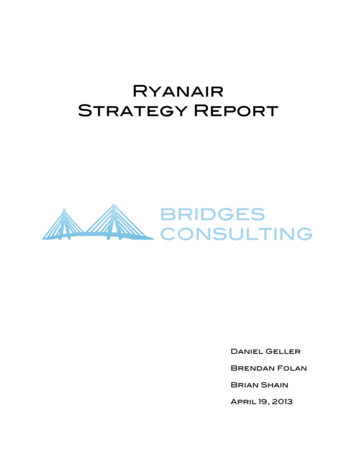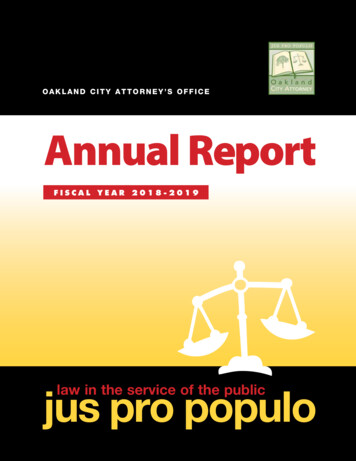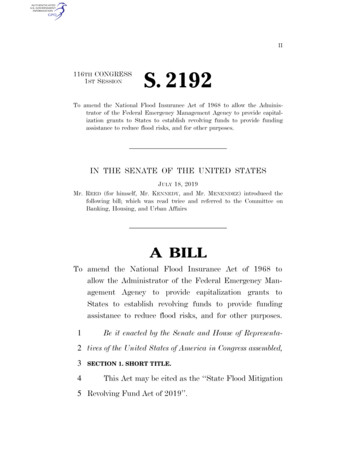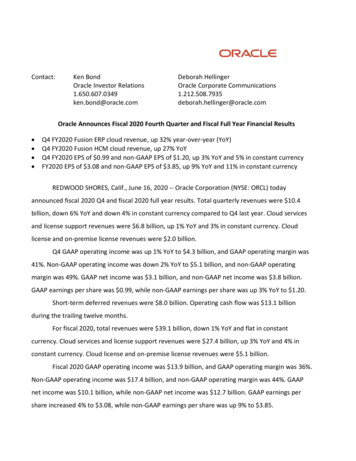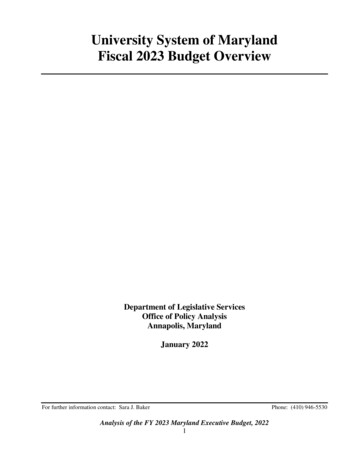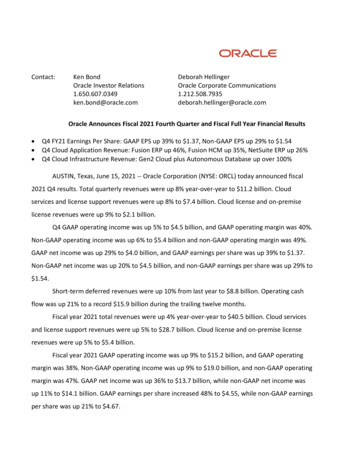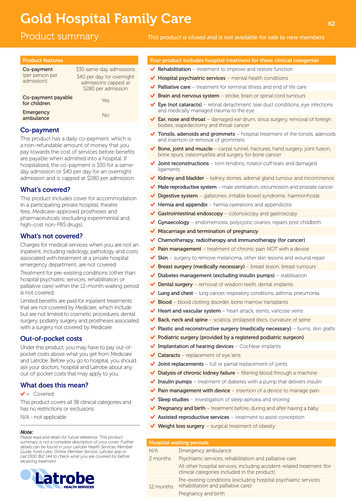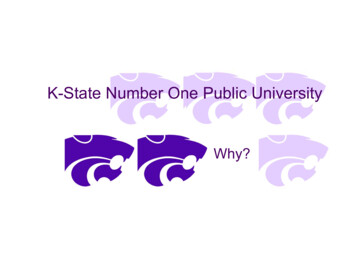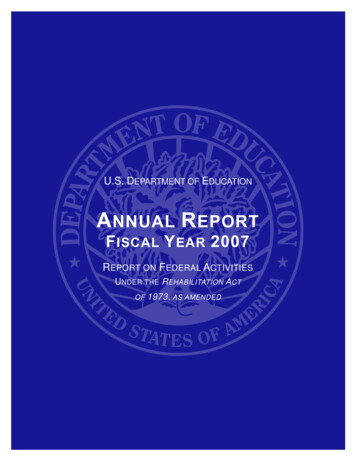
Transcription
U.S. DEPARTMENT OF EDUCATIONA NNUAL R EPORTF ISCAL Y EAR 2007REPORT ON FEDERAL ACTIVITIESU NDER THE REHABILITATION ACTOF1973, AS AMENDED
REHABILITATION SERVICES ADMINISTRATIONREPORT ON FEDERAL ACTIVITIESUNDER THE REHABILITATION ACT OF 1973, AS AMENDEDU.S. Department of EducationOffice of Special Education and Rehabilitative Services
U.S. Department of EducationArne DuncanSecretaryOffice of Special Education and Rehabilitative ServicesAlexa PosnyAssistant SecretaryRehabilitation Services AdministrationLynnae M. RuttledgeCommissionerJanuary 2012This report is in the public domain. Authorization to reproduce it in whole or in part isgranted. While permission to reprint this publication is not necessary, the citation shouldbe: U.S. Department of Education, Office of Special Education and RehabilitativeServices, Rehabilitation Services Administration, Annual Report, Fiscal Year 2007,Report on Federal Activities Under the Rehabilitation Act, Washington, DC 20202.To order copies of this report,write to: ED Pubs, Education Publications Center, U.S. Department of Education,P.O. Box 22207, Alexandria, VA 22304; orfax your request to: 703-605-67944; ore-mail your request to: edpubs@inet.ed.gov; orcall in your request toll-free to: 1-877-433-7827 (1-877-4-ED-PUBS). Those who use atelecommunications device for the deaf (TDD) or a teletypewriter (TTY) should call1-877-576-7734. If 877 service is not yet available in your area, call 1-800-872-5327(1-800-USA-LEARN); ororder online at: http://edpubs.gov.On request, this document can be made available in accessible formats, such as Braille,large print, and compact disc. For more information, please contact theU.S. Department of Education’s Alternative Format Center at 202-260-0852 or202-260-0818.
CONTENTSFigures . vTables . viiAbbreviations .ixForeword .xiThe Rehabilitation Act: An Overview . 3Programs Under the Rehabilitation Act . 9Employment Programs. 11Vocational Rehabilitation Services Program . 11Supported Employment Services Program . 26American Indian Vocational Rehabilitation Services Program . 29Demonstration and Training Program . 32Migrant and Seasonal Farmworkers Program . 36Projects With Industry . 42Randolph-Sheppard Vending Facility Program . 43Independent Living and Community Integration . 45State Independent Living Services Program. 45Centers for Independent Living Program . 46Independent Living Services for Older Individuals Who Are Blind . 48Recreational Program . 49Technical Assistance, Training and Support . 53Program Improvement . 53Capacity-building for Traditionally Underserved Populations . 55Rehabilitation Training Program . 57Institute on Rehabilitation Issues . 63Evaluation, Research and Information Dissemination . 65Program Evaluation . 65Information Clearinghouse. 68National Institute on Disability and Rehabilitation Research . 69Advocacy and Enforcement . 93Client Assistance Program . 94Protection and Advocacy of Individual Rights Program . 95Employment of People With Disabilities . 98Architectural and Transportation Barriers Compliance Board . 98Electronic and Information Technology. 99Employment under Federal Contracts . 99Nondiscrimination in Programs That Receive Federal Financial Assistance . 100National Council on Disability . 101RSA Fiscal Year 2007 Annual ReportPage iii
Appendix A . 105Appendix B . 117Appendix C . 127References . 135RSA Fiscal Year 2007 Annual ReportPage iv
FIGURESFigure 1.The Rehabilitation Act of 1973, as Amended, by Name of Title . 3Figure 2.Overall State VR Agency Performance for Evaluation Standard 1,Fiscal Years 2006 and 2007 . 19Figure 3.Key Indices of VR Programs, Fiscal Years 2006 and 2007 . 21Figure 4.VR Program Participants Achieving Employment,Fiscal Years 1996-2007 . 21Figure 5.VR Program Participants Achieving Competitive Employment,Fiscal Years 2004-2007 . 24RSA Fiscal Year 2007 Annual ReportPage v
TABLESTable 1.State VR Agency Performance on Standard 1, by Performance Indicator andType of Agency: Fiscal Year 2007 . 18Table 2.State VR Agency Performance on Standard 2, by Performance Factors andType of Agency: Fiscal Year 2007 . 20Table 3.Individuals Obtaining Employment After Exiting a VR Program,Fiscal Years 1995–2007 . 23Table 4.American Indian VR Services Program: Number of Grants and Funding Amounts,Fiscal Years 1999-2007 . 29Table 5.Number of Individuals Served, Exiting and Achieving Employment Through theAmerican Indian VR Services Program, Fiscal Years 1997-2007 . 30Table 6.Migrant and Seasonal Farmworkers Program: Number of Grants,Fiscal Years 2000-07 . 38Table 7.Projects With Industry Program Outcomes, Fiscal Years 2006 and 2007 . 42Table 8.Randolph-Sheppard Program Outcomes, Fiscal Years 2006 and 2007 . 44Table 9.Centers for Independent Living Program Accomplishments, Fiscal Year 2007 . 47Table 10.Recreational Programs: Number of Continuation and New Grant Awards,Fiscal Years 2003–07 . 49Table 11.Rehabilitation Training Program: Number of Grants and Funding Amounts,Fiscal Year 2007 . 61Table 12.Advanced Rehabilitation Research Training (ARRT) Projects: Selected Indicators,July 2006 to June 2007 . 85Table 13.Switzer Research Fellowship Program Accomplishments, July 2006 to June 2007 . 85Table 14.Total and Average Number per Award of NIDRR Peer-reviewed Publications forCalendar Year 2006, by Program. 91Table 15.Number of Awards and Grant Amount per Award for NIDRR-Funded Centers andProjects, by Type of Award: Fiscal Years 2006 and 2007 . 92Table A-1. Employment Outcomes (Evaluation Standard 1) of State VR Agencies ServingIndividuals Who Are Blind and Visually Impaired, by Indicator and Jurisdiction,Fiscal Year 2007. 105Table A-2. Employment Outcomes (Evaluation Standard 1) of State VR Agencies—General and Combined, by Indicator and Jurisdiction, Fiscal Year 2007 . 108Table A-3. Equal Access to Service (Evaluation Standard 2) of State VR Agencies ServingIndividuals Who Are Blind and Visually Impaired, by Indicator and Jurisdiction,Fiscal Year 2007. 113Table A-4.Equal Access to Service (Evaluation Standard 2) of State VR Agencies—General and Combined, by Indicator and Jurisdiction, Fiscal Year 2007. 114RSA Fiscal Year 2007 Annual ReportPage vii
Table B.Amount of Grant Awards to State VR Agencies, Number and Percentage of IndividualsWith Disabilities Employed, and Percentage Change in Each Category, by Type ofAgency and Jurisdiction, Fiscal Years 2006 and 2007 . 119RSA Fiscal Year 2005 Annual ReportPage viii
CBVICFRCHIEFCILCMCRDCSPDDBTACDD ull TermArchitectural Barriers ActAmericans with Disabilities ActAmerican Indian Vocational Rehabilitation ServicesAdvanced Rehabilitation Research TrainingAssistive TechnologyAdvanced Television Systems CommitteeBusiness Advisory CouncilBusiness Enterprise ProgramClient Assistance ProgramCommission for the Blind and Visually ImpairedCode of Federal RegulationsCraig Hospital Inventory of Environmental FactorsCenter for Independent LivingCommon MeasureCivil Rights DivisionComprehensive System of Personnel DevelopmentDisability and Business Technical Assistance CenterDevelopmental Disabilities Assistance and Bill of Rights ActDepartment of LaborDisability and Rehabilitation Research ProjectsDesignated State UnitEqual Employment Opportunity CommissionFederal Communications CommissionField-Initiated ProjectsFiscal YearGovernment Performance and Results ActGeneral Services AdministrationInteragency Committee on Disability ResearchIndependent LivingIndividualized Plan for EmploymentInstitute on Rehabilitation IssuesKnowledge Dissemination and UtilizationMultiple SclerosisRSA Fiscal Year 2007 Annual ReportPage ix
CISHRMSILCSILSSRCTBIUKVRWIAWISCIFull TermNational Alliance for Migrant andSeasonal Farmworkers Vocational RehabilitationNational Council on DisabilityNational Clearinghouse of Rehabilitation Training MaterialsNational Institute on Disability and Rehabilitation ResearchNational Vocational Rehabilitation Technical Assistance CenterOffice of the Chief Information OfficerOffice for Civil RightsOffice of Federal Contracts Compliance ProgramsOffice of Management and BudgetOffice of Special Education ProgramsOffice of Special Education and Rehabilitative ServicesProtection and AdvocacyProtection and Advocacy for Assistive TechnologyProtection and Advocacy of Individual RightsProgram Assessment Rating ToolProjects With IndustryRehabilitation Engineering Research CenterRehabilitation Engineering andAssistive Technology Society of North AmericaRehabilitation Research and Training CenterRehabilitation Services AdministrationState Board for Educator CertificationSmall Business Innovative ResearchSpinal Cord InjurySociety for Human Resource ManagementStatewide Independent Living CouncilState Independent Living ServicesState Rehabilitation CouncilTraumatic Brain InjuryUnited KingdomVocational RehabilitationWorkforce Investment ActWalking Index for Spinal Cord InjuryRSA Fiscal Year 2007 Annual ReportPage x
FOREWORDThe Rehabilitation Act of 1973, as amended (Rehabilitation Act),provides the statutory authority for programs and activities thatassist individuals with disabilities in the pursuit of gainfulemployment, independence, self-sufficiency and full integrationinto community life.This report is intended to provide a description ofaccomplishments and progress made under the RehabilitationAct during fiscal year (FY) 2007 (October 2006 throughSeptember 2007). To that end, the report identifies majoractivities that occurred during that fiscal year and the status ofthose activities during that specific time period.The report provides a description of the activities of theRehabilitation Services Administration (RSA), a component of theOffice of Special Education and Rehabilitative Services (OSERS),U.S. Department of Education. RSA is the principal agency forcarrying out Titles I, III, VI and VII, as well as specified portions ofTitle V of the Rehabilitation Act. RSA has responsibility forpreparing and submitting this report to the president and Congressunder Section 13 of the Rehabilitation Act.The Rehabilitation Act also authorizes research activities thatare administered by the National Institute on Disability andRehabilitation Research (NIDRR) and the work of the NationalCouncil on Disability (NCD), and includes a variety of provisionsfocused on rights, advocacy and protections for individuals withdisabilities. A description of those activities is provided inthis report.RSA Fiscal Year 2007 Annual ReportPage xi
THE REHABILITATION ACTAN OVERVIEW
THE REHABILITATION ACT: AN OVERVIEWFederal interest and involvement in rehabilitation issues and policy date initially from theenactment of the Smith-Fess Act of 1920. The Smith-Fess Act marked the beginning ofa federal and state partnership in the rehabilitation of individuals with disabilities.Although the law was passed shortly after the end of World War I, its provisions werespecifically directed at the rehabilitation needs of persons who were industrially disabled(due to accidents in factories) rather than those of disabled veterans.A major event in the history of the federal rehabilitation program was the passage of theRehabilitation Act of 1973, as amended (the Rehabilitation Act). The Rehabilitation Actprovides the statutory authority for programs and activities that assist individuals withdisabilities1 in the pursuit of gainful employment, independence, self-sufficiency, and fullintegration into community life. Under the Rehabilitation Act, the following federalagencies and entities are charged with administering a wide variety of programs andactivities: the departments of Education, Labor and Justice, the Equal EmploymentOpportunity Commission, the Architectural and Transportation Barriers ComplianceBoard, and the National Council on Disability.The U.S. Department of Education has primary responsibility for administering theRehabilitation Act. The Department’s Office of Special Education and RehabilitativeServices (OSERS) is the administrative entity responsible for oversight of the programsunder the Rehabilitation Act that are funded through the Department. Within OSERS,the Rehabilitation Services Administration (RSA) and the National Institute on Disabilityand Rehabilitation Research (NIDRR) share responsibility for carrying out theadministration of those programs. RSA is the principal agency for carrying out titles I, III,VI and VII, as well as specified portions of Title V of the Rehabilitation Act. NIDRR isresponsible for administering Title II of the Rehabilitation Act. (See fig. 1 for title names.)Figure 1.Title1The Rehabilitation Act of 1973, as Amended, by Its Various TitlesNameIVocational Rehabilitation ServicesIIResearch and TrainingIIIProfessional Development and Special Projects and DemonstrationsIVNational Council on DisabilityVRights and AdvocacyVIEmployment Opportunities for Individuals with DisabilitiesVIIIndependent Living Services and Centers for Independent LivingAn individual with a disability is defined, for purposes of programs funded under the Rehabilitation Act, at Section 7(20) of the act(see Definition of ―Individual with a Disability‖ as listed in Section 7(20) of the Rehabilitation Act, p. 101).RSA Fiscal Year 2007 Annual ReportPage 3
RSA administers grant programs that provide direct support for vocational rehabilitation(VR), independent living, and individual advocacy and assistance. The agency alsosupports training and related activities designed to increase the number of qualifiedpersonnel trained in providing VR and other services. RSA also provides training grants toupgrade the skills and credentials of employed personnel.In addition, RSA conducts model demonstrations and systems-change projects toimprove services provided under the Rehabilitation Act, evaluates programs to assesstheir effectiveness, and identifies best practices. Finally, RSA conducts monitoring,provides technical assistance, and disseminates information to public and privatenonprofit agencies and organizations to facilitate meaningful and effective participationby individuals with disabilities in employment and in the community.By far, the largest program administered by RSA is the State Vocational RehabilitationServices Program, also known as the ―Vocational Rehabilitation State Grants Program‖(hereinafter referred to as the ―VR program‖). This program funds state VR agencies toprovide employment-related services for individuals with disabilities so that they mayprepare for and engage in gainful employment that is consistent with their strengths,resources, priorities, concerns, abilities, capabilities, interests, and informed choice.For more than 85 years, the VR program has helped individuals with physical disabilities2not injured as a result of military service to prepare for and enter into the workforce.Nationwide, the VR program serves more than 1 million people with disabilities each year.More than 91 percent of the people who use state VR services have significant physical ormental disabilities that seriously limit one or more functional capacities. These individualsoften require multiple services over an extended period of time. For them, VR services areindispensable to their becoming employed and reducing their reliance on public support.Under Title II of the Rehabilitation Act, NIDRR conducts comprehensive andcoordinated programs of research, demonstration projects, training, and relatedactivities. NIDRR-funded programs and activities are designed to promote employment,independent living, maintenance of health and function, full inclusion and integration intosociety, and the transfer of rehabilitation technology to individuals with disabilities. Theintent is to improve the economic and social self-sufficiency of individuals withdisabilities and the effectiveness of programs and services authorized under theRehabilitation Act.Toward that goal, NIDRR supports rehabilitation research and development,demonstration projects, and related activities, including the training of persons whoprovide rehabilitation services or who conduct rehabilitation research. In addition, NIDRRsupports projects to disseminate and promote the use of information concerningdevelopments in rehabilitation procedures, methods, and devices. Information is providedto rehabilitation professionals, persons with disabilities, and their representatives. NIDRRalso supports data analyses on the demographics of disability and provides that2The Civilian Vocational Rehabilitation Act, passed by Congress in 1920, defined vocational rehabilitation (VR) as a program forphysical disabilities. Mental disabilities were not part of the VR program until 1943.RSA Fiscal Year 2007 Annual ReportPage 4
information to policymakers, administrators, and other relevant groups. Awards arecompetitive, with applications reviewed by panels of experts, including rehabilitationprofessionals, rehabilitation researchers, and persons with disabilities.The Rehabilitation Act has been a driving force behind major changes that have sinceaffected the lives of millions of individuals with disabilities in this country. The passageof the Workforce Investment Act of 1998 (WIA) was the most recent reauthorization ofthe Rehabilitation Act. This report, covering FY 2007, describes all of the majorprograms and activities authorized under the Rehabilitation Act and the success of thefederal government in carrying out the purposes and policies outlined in theRehabilitation Act.RSA Fiscal Year 2007 Annual ReportPage 5
PROGRAMS UNDERTHE REHABILITATION ACT
PROGRAMS UNDERTHE REHABILITATION A CTThrough partnerships with other federal and nonfederal agencies, RSA directly funds orsupports a wide variety of programs, initiatives, or activities that are authorized underthe Rehabilitation Act. For the purpose of this report, these programs, initiatives, andactivities are organized into five major areas: Employment Programs; IndependentLiving and Community Integration; Technical Assistance, Training, and Support;Evaluation, Research, and Information Dissemination; and Advocacy and Enforcement.Within each area, the report provides a description of the discrete program, initiative, oractivity. Each description includes a budget allocation for FY 2007 and a report of majoroutcomes and accomplishments. Programs, organized by these areas, are:Employment Programs Vocational Rehabilitation Services ProgramSupported Employment Services ProgramAmerican Indian Vocational Rehabilitation Services ProgramDemonstration and Training ProgramMigrant and Seasonal Farmworkers ProgramProjects With IndustryRandolph-Sheppard Vending Facility Program (also known as the BusinessEnterprise Program)Independent Living and Community Integration State Independent Living Services ProgramCenters for Independent Living ProgramIndependent Living Services for Older Individuals Who Are BlindRecreational ProgramsTechnical Assistance, Training, and Support Program ImprovementCapacity Building for Traditionally Underserved PopulationsRehabilitation Training ProgramInstitute on Rehabilitation IssuesRS A F I S C A L Y E A R 2 00 7 A N N U A L R E P O RTPA G E 9
Evaluation, Research, and Information Dissemination Program EvaluationInformation ClearinghouseNational Institute on Disability and Rehabilitation ResearchAdvocacy and Enforcement Client Assistance ProgramProtection and Advocacy of Individual Rights ProgramEmployment of People With DisabilitiesArchitectural and Transportation Barriers Compliance BoardElectronic and Information TechnologyEmployment Under Federal ContractsNondiscrimination in Programs That Receive Federal Financial AssistanceNational Council on DisabilityRS A F I S C A L Y E A R 2 00 7 A N N U A L R E P O RTPA G E 1 0
EMPLOYMENT PROGRAMSRSA administers seven programs that assist individuals with disabilities to achieveemployment outcomes3. Two of these programs, the Vocational Rehabilitation ServicesProgram (VR program) and the Supported Employment Services Program, are stateformula grant programs. The American Indian Vocational Rehabilitation Services,Demonstration and Training, Migrant and Seasonal Farmworkers, and the Projects WithIndustry programs are discretionary grant programs that make competitive awards forup to a five-year period. RSA also provides oversight of the Randolph-SheppardVending Facility Program (also known as the Business Enterprise Program) operated bystate VR agencies for individuals who are blind or visually impaired. Each of theseprograms is described below.VOCATIONAL REHABILITATION SERVICES PROGRAMAuthorized Under Sections 100–111 of the Rehabilitation ActThrough the Vocational RehabilitationVocational RehabilitationServices Program, RSA provides grants toServices Programstates to operate a VR program as an integralFY 2007 Federal Fundingpart of a coordinated, statewide workforce 2,802,716,000investment system. The program is designedto provide VR services to eligible individualswith disabilities so that they may achieve an employment outcome that is consistentwith their strengths, resources, priorities, concerns, abilities, capabilities, interests, andinformed choice.The federal government covers 78.7 percent of the program's costs through financialassistance to the states4 for program services and administration. Federal funds aretransferred to the states based on a statutory formula in Section 8 of the RehabilitationAct. The formula takes into consideration a state’s population and per capita income.To match the federal funds allotted to the states for the VR program, states expended 833,809,272 of their own funds.Each state designates a state agency to administer the VR program. The RehabilitationAct provides flexibility for a state to have two state VR agencies—one for individualswho are blind and one for individuals with other types of disabilities. All 56 states—50U.S. states, D.C., Puerto Rico and the territories—have VR agencies; however, 24 of34―Employment outcome means (according to the program regulations at 34 CFR 361.5(b)(16)), with respect to an individual, enteringor retaining full-time or, if appropriate, part-time competitive employment in the integrated labor market; supported employment; orany other type of employment in an integrated setting, including self-employment, telecommuting or business ownership, that isconsistent with an individual’s strengths, resources, priorities, concerns, abilities, capabilities, interests and informed choice.‖―States‖ in this publication refers to each of the states of the United States, the District of Columbia, the Commonwealth of PuertoRico, the United States Virgin Islands, Guam, American Samoa, and the Commonwealth of the Northern Mariana Islands, accordingto the Rehabilitation Act, Section 7(32).RS A F I S C A L Y E A R 2 00 7 A N N U A L R E P O RTPA G E 11
those entities also have separate agencies serving blind or visually impaired individuals,for a total of 80 state VR agenciesThe Rehabilitation Act also provides flexibility to the states with respect to theorganizational positioning of the VR program within the state structure. The VRprogram can be located in one of two types of state agencies—one that is primarilyconcerned with VR or VR and other rehabilitation of individuals with disabilities, or anagency that is not primarily concerned with VR or VR and other rehabilitation ofindividuals with disabilities. For the latter, the Rehabilitation Act requires the agency tohave a designated state VR unit that is primarily concerned with VR or VR and otherrehabilitation of individuals with disabilities. Of the 80 VR agencies, 25 are primarilyconcerned with VR and other rehabilitation of individuals with disabilities. Of these, 10are consumer-controlled agencies. Of the 55 agencies that are not primarily concernedwith VR or VR and
Table 7. Projects With Industry Program Outcomes, Fiscal Years 2006 and 2007 . 42 Table 8. Randolph-Sheppard Program Outcomes, Fiscal Years 2006 and 2007. 44 Table 9. Centers for Independent Living Program Accomplishments, Fiscal Year 2007 . 47 Table 10.
